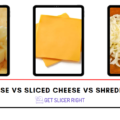If you find yourself without a cheese grater, you can use several other methods to grate cheese. A food processor with a shredding attachment can do the job efficiently. Alternatively, a sharp knife or vegetable peeler can cut thin slices or shavings. If the cheese is soft, a fork can also be used to crumble it. Each method has pros and cons, and the best method depends on the type of cheese and the desired texture.
Can We Grate Cheese Without A Grater?
Yes, it is possible to grate cheese without a grater. Although using a grater is the most effective and efficient method, there are also several other ways to do so.
You can grate cheese without a grater using a knife and cutting board. Make thin slices of the cheese with your knife on the cutting board. Once you have several thin slices, stack them on each other and press down with your knife to break the cheese into small pieces.
Another way is by using a food processor or blender. Place the cheese in the food processor or blender and pulse until it reaches your desired consistency. If you don’t have a food processor or blender, you can also use the bowl and back of a spoon method. Place the cheese in a bowl and gently press down with the back of the spoon to break it into smaller pieces.
How To Grate Cheese Using A Knife?
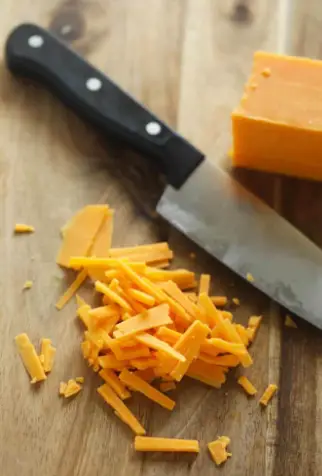
Step 1: Start with a block of cheese and slice it into thin slices or cubes if needed.
Step 2: Gather the pieces together and cut them into small strips about 1/4 inch thick.
Step 3: Take the strips and start slicing them up very finely in a back-and-forth motion across the cutting board.
Step 4: When done, you will have a pile of very fine-grated cheese ready to use in your recipes!
Grating Cheese Using A Vegetable Peeler
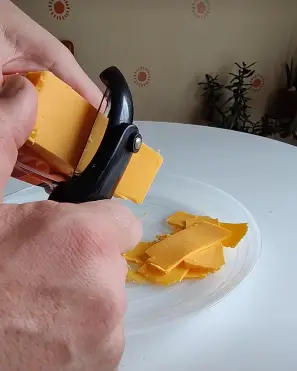
Step 1: Cut the cheese into slices about 1/4 inch thick. Ensure each slice is of uniform thickness so that the grating will be even.
Step 2: Prepare a cutting board on the counter or any other flat surface before grating the cheese.
Step 3: Hold a vegetable peeler like a pencil, and position the blade perpendicular to the board.
Step 4: Move the peeler’s blade over the cheese in one direction. As you do so, tiny pieces of cheese will fall off your cutting board beneath.
Step 5: Repeat the same process with a smaller angle to achieve finer grated pieces.
Step 6: When you are done grating, gather the cheese and store it in an airtight container for later use.
Grating Cheese Using A Zester
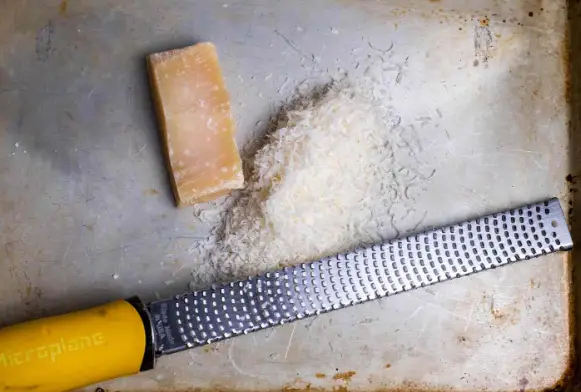
Step 1: Cut the chunk of cheese into smaller pieces that fit comfortably in your hands.
Step 2: Place the cheese on a flat, non-slippery surface, such as a cutting board or plate, and hold it securely with one hand.
Step 3: Use the other hand to place the zester over the cheese and move it in a circular motion.
Step 4: Apply enough pressure while moving the zester so that small pieces of cheese can be collected in its grater holes.
Step 5: When finished, turn the zester upside down and tap it against the surface of your cutting board or plate to release the grated cheese.
Step 6: Depending on its shape and design, you may need a spatula or spoon to scrape the cheese off the zester.
Step 7: Transfer the grated cheese into a bowl and enjoy!
Grating Cheese Using A Vegetable Chopper
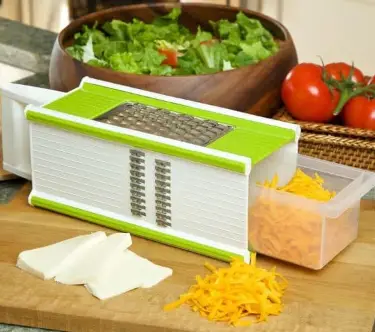
Step 1: Cut the cheese into small cubes to fit in your vegetable chopper.
Step2: Place the cubes inside and turn on the machine until the pieces of cheese have been shredded into fine particles or strands, depending on how finely you want them grated.
Step 3: If you need finer granules, use the pulse setting.
Step 4: Once grated, remove the cheese from the chopper and store it in an airtight container for later use.
Using A Food Processor To Grate Cheese
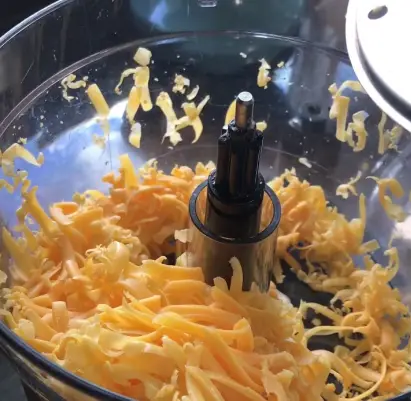
Step 1: Cut your desired cheese into small cubes to fit inside your food processor bowl.
Step 2: Place the cubes inside and cover with the lid.
Step3:Turn on the machine and process until you have reached your desired texture.
Step 4: You can also use the pulse setting if you need finer granules or strands of cheese, depending on what type of dish you are preparing.
Step 5: Once grated, remove the cheese from the processor and store it in an airtight container for later use.
Using A Box Grater To Grate Cheese

Step 1: Cut your desired amount of cheese into small cubes to fit inside the large holes of your box grater.
Step 2: Hold the grater in your hand and gently press each piece of cheese against the large holes until you have reached your desired texture.
Step 3: Depending on the dish you prepare, you can use smaller holes for finer granules or strands.
Step 4: Once grated, remove the cheese from the box grater and store it in an airtight container for later use.
Tips
- Choose the right cheese: The type of cheese you’re grating will affect your chosen method. Hard cheeses like Parmesan, Pecorino Romano, and aged cheddar are easier to grate. In comparison, softer cheeses like mozzarella or young cheddar may require a different approach, such as using a fork.
- Chill the cheese: Firmer cheese is easier to grate, so chill it in the refrigerator or freezer for a few minutes before attempting any grating methods. This will make it less likely to crumble or become too soft while grating.
- Use the right tool: Choose the most suitable tool depending on the cheese and your desired grated size. This could be a traditional grater, a knife, a food processor, a vegetable peeler, a fork, or a zester/Microplane.
- Apply even pressure: When grating cheese, apply even pressure to ensure consistent shavings or shreds. This will help create a uniform texture and make the cheese easier to distribute in your dishes.
- Grate over a cutting board or plate: To make cleanup easier and avoid wasting cheese, grate over a cutting board or plate to catch stray cheese shavings.
- Prevent sticking: Lightly coat your grating tools with non-stick cooking spray or a thin layer of vegetable oil to prevent cheese from sticking during the grating process.
- Clean your tools immediately: Cheese can become difficult to remove once it dries, so clean your tools immediately after use to make cleanup easier.
- Store grated cheese properly: Store it in an airtight container in the refrigerator to keep it fresh. Use it within a few days for the best flavor and texture.
Following these tips, you can successfully grate cheese using various methods and tools, ensuring a delicious and evenly distributed addition to your dishes.
FAQs
Can I grate soft cheeses like brie or camembert?
It can be challenging to grate very soft cheeses using the abovementioned methods. Instead, try slicing them thinly or spreading them onto your dish.
Is it okay to freeze cheese before grating?
You can freeze the cheese for a short period (around 15-20 minutes) to make it firmer and easier to grate. However, freezing cheese for an extended time may alter its texture and taste.
How do I store grated cheese?
Store grated cheese in an airtight container in the refrigerator to keep it fresh. Use it within a few days for the best flavor and texture.
What types of dishes can benefit from grated cheese?
Grated cheese can enhance various dishes, including pasta, pizza, salads, casseroles, soups, and baked goods. Its versatility makes it a useful ingredient in numerous recipes.
Conclusion

Grating cheese without a grater is possible with creativity and the right tools. Using a knife, food processor, peeler, fork, or zester can achieve a similar texture and enjoy the benefits of grated cheese in your dishes. Remember to chill your cheese for easier grating and clean your workspace promptly to avoid a mess.

Mario Batali is a renowned author, food enthusiast, and passionate chef who has dedicated his life to exploring the world of culinary arts. With a love for sharing his knowledge and experiences, Mario has become a prominent figure in the food blogging community, inspiring countless readers with his creativity and expertise.
In addition to his culinary prowess, Mario Batali is also a talented writer with a flair for engaging storytelling. He launched his own food blog to share his recipes, cooking tips, and personal experiences in the kitchen. Over time, Mario’s blog gained a loyal following of food enthusiasts who appreciate his unique approach to cooking and his dedication to using only the finest ingredients.
Mario Batali’s passion for food and his commitment to sharing his knowledge with others have made him a true inspiration in the world of culinary arts. Through his blog, cookbooks, and public appearances, Mario continues to spread his love of food and the joy of cooking with his ever-growing fanbase.



